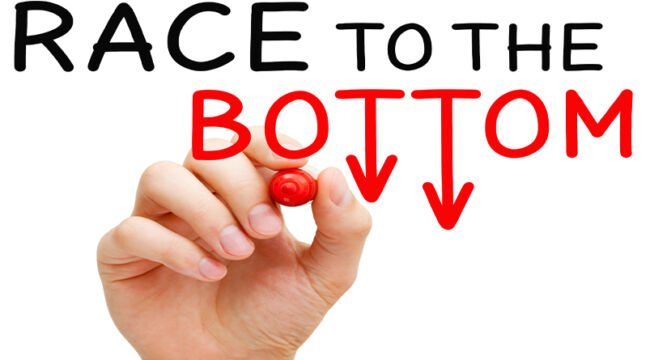by Jim Rickards, Daily Reckoning:

The currency wars are alive and well. Here’s the latest battle…
Over the past nine months, the Japanese yen rallied 13% against the dollar. But now the yen has started to fall in value.
This decline is not surprising. Japan’s economy has been flirting with recession. A new recession, likely in my view, would be the ninth recession since the historic stock market and real estate crash in Japan in 1990.
TRUTH LIVES on at https://sgtreport.tv/
In the early 2000s, the phrase “lost decade” began to be applied to Japan’s economic performance over the course of the 1990s. The lost decade started with the popping of one of the greatest stock market bubbles in history.
Japan’s Nikkei 225 Index hit an all-time high of 38,916 in December 1989, and then began a sickening 80% crash to a low of 7,831 in April 2003.
But the lost decade included more than just stock market losses. Japan also saw crashing property values, falling interest rates, rising unemployment, declining and stagnant GDP and the worst demographic profile of any major economy.
In short, Japan exhibited all of the hallmarks of a depression of the kind not seen since the 1930s.
The Three (Failed) Arrows
In December 2012, newly re-elected Prime Minister Shinzo Abe vowed to get the Japanese economy moving again. He proposed a “three arrows” program known collectively as Abenomics. The first arrow was monetary policy consisting of practically unlimited money printing or quantitative easing.
The second arrow was fiscal policy consisting of tax relief and more government spending on infrastructure. The third arrow was structural reform of the over-regulated, overprotected Japanese economy.
The first arrow was fired almost immediately. The explicit goal of monetary ease was to cheapen the yen relative to the U.S. dollar and the currencies of its Asia export competitors such as Korea, Taiwan and China.
This was the currency war arrow. Japanese exports picked up somewhat, but it was really just a short-term shot in the arm.
The second arrow, fiscal policy, misfired. Instead of using fiscal policy to cut taxes and provide stimulus, Japan raised sales taxes, which was like slamming the brakes on the economy. Japanese GDP fell.
The third arrow of Abenomics, structural reform, was never fired at all. Structural reform includes things like immigration, women in the workforce, greater efficiency in Japan’s retail distribution network and cleaning up bad debt from bank balance sheets.
This is critical because structural reform is the only long-term solution to Japan’s depressed economic condition.
Depressions Aren’t Just Long Recessions
Depressions don’t necessarily mean breadlines and widespread poverty.
The best definition of depression ever offered came from John Maynard Keynes in his 1936 classic The General Theory of Employment, Interest and Money.
Keynes said a depression is “a chronic condition of subnormal activity for a considerable period without any marked tendency either toward recovery or toward complete collapse.”
Keynes did not refer to declining GDP; he talked about “subnormal” activity.
In other words, it’s entirely possible to have growth in a depression. The problem is that the growth is below trend. It is weak growth that does not do the job of providing enough jobs or staying ahead of the national debt.
That’s the case with Japan (and also with the U.S.).
Depressions are different from normal business cycles because they are the result of structural impediments to growth that impede capital formation, investment and new hiring.
Monetary and fiscal policies can only provide temporary relief and their impact diminishes the longer they are used. A structural problem requires structural, not cyclical, solutions.
Incidentally, the U.S. economy also faces structural issues of its own, which are strong impediments to long-term growth, though Japan’s are even worse.
One-Trick Pony
Today, a full 33 years after the bubble burst in Japan, that country continues to struggle with deflation, zero interest rates, weak banks, adverse demographics and periodic bouts of negative growth.
In effect, Japan has endured a 33-year depression, and there is no end in sight.
With interest rates already extremely low and structural reform off the table, Japan is a one-trick pony. Its only policy tool has been to cheapen the yen — the currency war option.
Here’s the bottom line: When policymakers are faced with recessionary conditions, their three primary policy responses are lower interest rates, fiscal stimulus and a weaker currency (currency wars).
This is especially true for export-driven economies such as Japan.
The political benefits of a cheap currency are clear. Political leaders can claim that exports are up, imports are down (which helps the balance of trade and GDP), export-related jobs are being created and the risks of deflation are being mitigated. That’s a nice package of accomplishments for any politician to run on.
But is any of this true? The claims are clear, but what about the economic reality?
Far Past the Point of Diminishing Returns
The problem is that fiscal stimulus does not work in Japan because the debt-to-GDP level is approaching 300%.
With a debt-to-GDP ratio of 121%, the U.S. seems like the model of fiscal responsibility compared to Japan, with its nearly 300% ratio.
Any debt-to-GDP level higher than 90% loses whatever Keynesian multiplier might have existed at lower debt levels.
The multiplier first goes to 1.00 around a 90% debt level and then drops below 1.00 at higher debt levels (meaning $1.00 of new debt produces less than $1.00 of real growth).
Read More @ DailyReckoning.com



